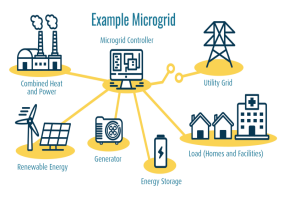Micro-grids: A Solution to the Energy Crisis
)
What is a micro-grid?
Microgrids are small-scale power systems that can operate independently or in conjunction with the main power grid. They typically consist of distributed energy resources (DERs) such as solar panels, wind turbines, batteries, and generators, as well as control systems that manage the flow of energy in and out of the grid. Microgrids are designed to provide reliable, secure, and cost-effective electricity to a specific group of customers, such as a community, a university campus, or an industrial facility.
They can operate in grid-connected mode, where they can sell excess energy to the main grid, or in islanded mode, where they are disconnected from the main grid and rely solely on their own resources. Microgrids are increasingly being used as a way to improve energy resilience, reduce greenhouse gas emissions, and increase the use of renewable energy sources.
How does a Microgrid Work?- Power Generation: The microgrid generates electricity from various sources, such as solar panels, wind turbines, or generators. The energy is stored in batteries or other energy storage systems for later use
- Control System: The microgrid control system manages the flow of energy in and out of the grid. It monitors the energy production and consumption in real-time and decides which energy sources to use based on the demand and availability.
- Power Distribution: The microgrid distributes power to the connected loads, such as homes, businesses, or industrial facilities. The power can be delivered through wires or wireless connections, depending on the application.
- Energy Storage: The microgrid can store excess energy in batteries or other energy storage systems for later use when the energy demand exceeds the supply. This can provide a backup power source in case of power outages or other emergencies.
- Connection to the Main Grid: The microgrid can operate in grid-connected mode, where it can sell excess energy to the main grid, or in islanded mode, where it is disconnected from the main grid and relies solely on its own resources.

Advantages of microgrids
Microgrids have several benefits to the environment, utility operators, and to customers.
1. Microgrids offer the opportunity to deploy more zero-emission electricity sources, thereby reducing greenhouse gas emissions. The microgrid manager (e.g., local energy management system) can balance generation from non-controllable renewable power sources, such as solar, with distributed, controllable generation, such as natural gas-fueled combustion turbines. They can also use energy storage and batteries in electric vehicles to balance production and usage within the microgrid.
2. Microgrids can make use of on-site energy that would otherwise be lost through transmission lines and heat that would otherwise be lost up the smokestack. When power must travel long distances (e.g., from a centralized power station), line losses occur, requiring additional generation to ensure that far away demand is met. Since microgrid electricity is generated next to where it will be used (also known as a distributed generation), line losses are minimized, and less power is required to meet the same level of demand. Also, when electricity is generated from certain centralized power sources (e.g., fossil fuels and nuclear power) a great deal of heat energy is created and typically released — unused — into the atmosphere. When power is generated close to the end users, it becomes economically feasible to use this heat energy productively, such as heating water or space in nearby homes and businesses, reducing greenhouse gas emissions.
3. Microgrids can improve local management of power supply and demand, which can help defer costly investments by utilities in new power generation. When sited strategically within the electricity system, microgrids help reduce or manage electricity demand and alleviate grid congestion, thereby lowering electricity prices and reducing peak power requirements. In this manner, microgrids may support system reliability, improve system efficiency, and help delay or avoid investment in new electric capacity (e.g., “Peaker” plants, substations, transmission lines, energy storage or other infrastructure). When connected to the local distribution network or transmission system, microgrids can also transact from a single node to export excess electricity or import imbalances from the surrounding system.
4. Microgrids can enhance grid resilience to more extreme weather or cyber-attacks. Microgrids can continuously power individual buildings, neighborhoods, or entire cities, even if the surrounding macro-grid suffers an outage. This concept of a microgrid functioning independently from the surrounding system is known as islanding. Microgrids can also help the microgrid recover from a system outage, either indirectly, by sustaining services needed by restoration crews, or directly, by helping to re-energize the macro grid.
Microgrids a solution in the futureThe future promises dramatic transformations in the way people make and consume energy. Many experts are turning to microgrids — small-scale, self-sustaining power networks unburdened by ties to a centralized power plant — as key agents of this transformation.
Microgrids provide everything from greater reliability and resilience to cleaner power and economic development. They’re designed to work in unison with distributed energy resources (DERs) that include solar panels, fuel cells, and battery storage. DERs are more reliable and potentially much cleaner than traditional methods.
As they grow in number and complexity, microgrids will require sophisticated digital automation and smart management to become reliable alternatives to the conventional grid. Today’s high proliferation of DERs often makes microgrids more complex than in the past.
Fortunately, advancements in information technology such as the Internet of Things (IoT) enable automated energy management. This can manage multiple components and changing conditions. A smart system makes full use of the IoT by embedding energy sources with sensors and electronics that connect it to both the microgrid and a cloud-based repository of real-time data. Based on these available parameters, the system can make decisions that optimize price, reliability, and the use of clean energy.

Conclusion
A microgrid is a group of interconnected loads, DERs (such as DGs and ESSs), and management systems that can operate either in grid-connected mode or islanded mode (Fig. 1). From the utility’s point of view, a microgrid appears as a single controllable entity that can consume or supply power depending upon the total generation and the total load inside the microgrid. The ability of a microgrid to operate in islanded mode increases the reliability of the load points. The islanding mode can occur if there is a fault within the microgrid or in the upstream network to which it is connected. In an islanded mode of operation, the loads depend upon the power generation of DGs connected to the microgrid. In the case when DGs are unable to supply all the load, energy management systems can voluntarily curtail the non-sensitive loads utilizing advanced switches and control strategies. This ensures that the sensitive loads are not interrupted.
References1. Department of Energy. (June 17, 2014). How Microgrids Work. Retrieved from energy.gov: https://energy.gov/articles/how-microgrids-work
2. Reliability Assessment of Microgrid with Renewable Generation and Prioritized Loads: https://asset-pdf.scinapse.io/prod/2566667744/2566667744.pdf
3. Why Microgrids Are On-Trend for the Future of Green Energy
https://innovationatwork.ieee.org/why-microgrids-are-on-trend-for-the-future-of-green-energy/
4. Microgrids: What are they and how do they work?” NSCI Blog, Nov. 8, 2019. Available: https://nsci.ca/2019/11/08/microgrids-what-are-they-and-how-do-they-work/
Author: Osaid Aqeel — Final year Electrical Engineering student at NED university
Disclaimer: The author of the blogs are the students of NED university of engineering and technology. Therefore, all the information and opinions expressed in the blogs are solely from the students. IET, UK have no direct access or contribution in any of the blogs.
Source: Medium
(Ambassador Contribution)
Melbourne Build is the leading and largest construction trade show for Melbourne and Victoria, taking place October 22nd & 23rd 2025 at MCEC. Featuring two jam-packed days of knowledge-sharing, 450+ expert speakers across 12 conference stages, a 175+ booth exhibition, Meet the Buyers, business networking, live music, entertainment and so much more! Don’t miss out on free tickets.

